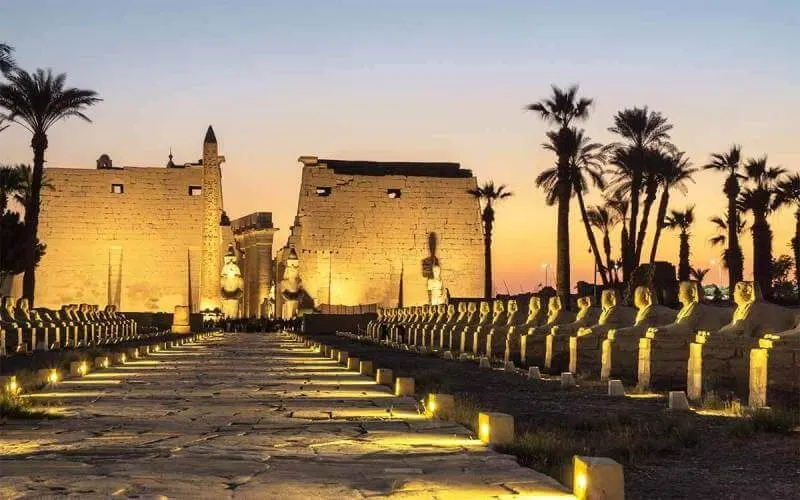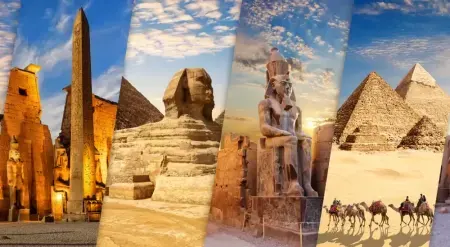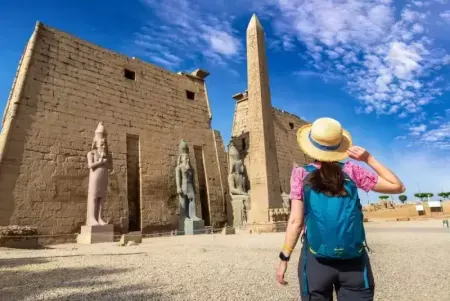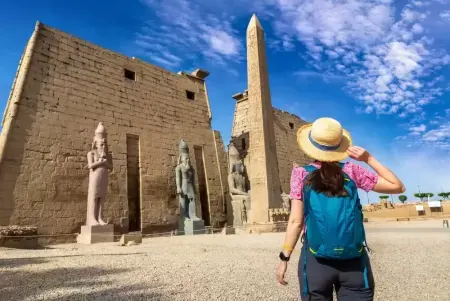Introduction to Luxor Temple
Located on the east bank of the Nile River in the city of Luxor, Luxor Temple is one of the most ancient and impressive structures in the world. It is a magnificent temple complex that was built during the New Kingdom period of Ancient Egypt, around 1400 BCE. The temple is dedicated to the god Amun, his wife Mut, and their son Khonsu. Luxor Temple is considered one of the most important religious sites in Egypt and is part of the UNESCO World Heritage Site known as the Ancient Thebes with its Necropolis.

History of Luxor Temple - who built it
The construction of Luxor Temple began during the reign of Amenhotep III, the ninth pharaoh of the 18th dynasty of Ancient Egypt. It was built on the site of an earlier temple that was constructed by Amenhotep's grandfather, Amenhotep II. The temple was then expanded and modified by later pharaohs, including Tutankhamun, Horemheb, and Ramesses II.
The temple was built to celebrate the annual Opet Festival, a major religious festival in Ancient Egypt that celebrated the union of the god Amun with the goddess Mut. During the festival, the statues of Amun, Mut, and Khonsu were taken from Karnak Temple, a larger temple complex located two miles north of Luxor Temple, and brought to Luxor Temple. The festival lasted for 27 days and was a time of great celebration and ritual.
Significance of Luxor Temple in Ancient Egyptian religion
Luxor Temple was considered one of the most important religious sites in Ancient Egypt. It was believed to be the place where the god Amun would manifest himself in his physical form, and where he would receive offerings and prayers from his followers. The temple was also considered a place of great power, and was believed to have the ability to bestow blessings and protection on those who visited it.
The temple was also home to a number of important religious ceremonies and rituals. One of the most important of these was the Opet Festival, which celebrated the union of Amun with Mut. The temple was also the site of the Sed Festival, a ceremony that was held to celebrate the pharaoh's jubilee and to reaffirm his power and authority.
Architecture of Luxor Temple
The architecture of Luxor Temple is a testament to the skill and artistry of the Ancient Egyptians. The temple is laid out in a traditional Egyptian temple style, with a series of courtyards, halls, and chambers. The temple's main entrance is through a massive pylon, or gateway, that is flanked by two massive statues of Ramesses II. Beyond the pylon is a large courtyard, surrounded by a series of smaller chambers and halls.
The most impressive part of the temple is the hypostyle hall, a massive hall with 134 columns arranged in 16 rows. The columns are each over 10 meters tall and are intricately carved with hieroglyphs and scenes from Egyptian mythology. The hall was used for a variety of religious ceremonies and rituals, and was considered one of the most sacred parts of the temple.
Exploration of the temple - main sections and features
The temple is divided into several main sections and features. The main entrance is through the pylon, which leads into the first courtyard. Beyond the courtyard is the hypostyle hall, which is considered the most impressive part of the temple. Beyond the hypostyle hall is the sanctuary, which was the most sacred part of the temple.
The sanctuary is a small chamber that contains a shrine to Amun, Mut, and Khonsu. The shrine is made of gold and is surrounded by a series of smaller chambers and rooms. The sanctuary was the site of a number of important religious ceremonies and rituals, and was considered the most powerful part of the temple.
When Was Luxor Temple Built?
The Luxor Temple was built during the New Kingdom period in ancient Egypt, around 1400 BCE. It was built to honor the god Amun, who was considered the king of all gods. The temple was constructed on the site of an older temple that was built by Amenhotep III, which was dedicated to the Theban Triad of gods – Amun, Mut, and Khonsu. However, the Luxor Temple was expanded and renovated over the centuries by many pharaohs including Tutankhamun, Ramses II, and Alexander the Great.
Where Is the Luxor Temple Located?
The Luxor Temple is located in the city of Luxor, which was the ancient capital of Egypt during the New Kingdom period. The temple is situated on the east bank of the Nile River, opposite the city of Karnak, which was also an important religious center in ancient Egypt. The Luxor Temple is easily accessible by car, taxi or public transport, and visitors can also take a boat ride across the Nile River to get to the temple.
How Big Is the Luxor Temple?
The Luxor Temple covers an area of about 25 hectares and is one of the largest and most impressive temples in Egypt. The temple is designed in the classic Egyptian architectural style, with a large courtyard, hypostyle hall, and several smaller chambers and sanctuaries. The hypostyle hall is particularly impressive, with 32 massive columns that are over 20 meters tall, and are adorned with intricate carvings and hieroglyphics.
How Old Is Luxor Temple?
The Luxor Temple is over 3,400 years old, and has been a significant religious and cultural site in Egypt for centuries. It was built during the New Kingdom period, which was a time of great prosperity and cultural achievement in ancient Egypt. The temple has survived numerous wars, invasions, and natural disasters over the centuries, and remains one of the best-preserved ancient Egyptian temples in the world.
Why Is the Luxor Temple Important?
The Luxor Temple is significant for several reasons. Firstly, it was one of the most important religious centers in ancient Egypt, and was dedicated to the god Amun, who was considered the king of all gods. The temple was also used for various ceremonies and festivals, and was an important political and economic center as well. Secondly, the Luxor Temple is a remarkable example of ancient Egyptian architecture and art, and is adorned with beautiful carvings, hieroglyphics, and statues that depict various gods, pharaohs, and other important figures. Finally, the Luxor Temple is also an important archaeological site, and has yielded many important discoveries over the years, including the remains of ancient buildings, artifacts, and inscriptions.
Luxor Temple Opening Hours
The Luxor Temple is open to visitors daily from 6:00 am to 10:00 pm. However, it is recommended to visit the temple in the early morning or late afternoon when it is less crowded and the light is more favorable for photography. Visitors are also advised to wear comfortable shoes and clothing, and to bring plenty of water and sunscreen as the temple can get very hot and dry during the day.
Unique facts and secrets about Luxor Temple
Despite being one of the most well-known and well-studied temples in Egypt, Luxor Temple still holds many secrets and mysteries. One of the most interesting of these is the fact that the temple was built on top of an even older temple, which was dedicated to the god Amun. The remains of this older temple can still be seen in the foundations of the current temple.
Another interesting fact about Luxor Temple is that it was used as a Christian church during the Roman period. Many of the temple's original features and decorations were destroyed or covered up during this time, but some traces of the original temple can still be seen.
Restoration and preservation of Luxor Temple
Luxor Temple has undergone a number of restoration and preservation projects over the years. In the 19th century, the temple was cleaned and restored by French archaeologist Gaston Maspero. More recently, the temple has undergone a major restoration project funded by the Egyptian government and UNESCO. The project involved cleaning and repairing the temple's walls and columns, as well as restoring some of the original decorations and features.
Visiting Luxor Temple - tips and recommendations
If you are planning a visit to Luxor Temple, there are a few things you should keep in mind. First, be sure to wear comfortable shoes, as the temple complex is quite large and involves a lot of walking. You should also bring plenty of water, as it can get quite hot in Luxor. It's also a good idea to bring a guidebook or hire a guide, as the temple is quite complex and can be difficult to navigate without some background knowledge.
Luxor Temple Entrance Fee
The entrance fee for the Luxor Temple varies depending on your nationality and age. For foreign tourists, the entrance fee is 200 Egyptian pounds (EGP), which is roughly equivalent to $12 USD. For students and children, the entrance fee is 100 EGP. However, if you are an Egyptian citizen or resident, the entrance fee is only 20 EGP.
Other temples in Luxor - a brief overview
Luxor is home to a number of other important temples, including Hatshepsut Temple, Valley of the kings, Karnak Temple, Medinet Habu, and the Ramesseum. Karnak Temple is the largest temple complex in Egypt and is located just two miles north of Luxor Temple. Medinet Habu is a temple complex that was built by Ramesses III and is located on the west bank of the Nile. The Ramesseum is a temple that was built by Ramesses II and is located on the west bank of the Nile.
Conclusion - the enduring legacy of Luxor Temple
Luxor Temple is a testament to the skill and artistry of the Ancient Egyptians. It is a magnificent temple complex that has been the site of religious ceremonies and rituals for thousands of years. Despite being thousands of years old, the temple still holds many secrets and mysteries, and continues to be a source of fascination and wonder for visitors from around the world. If you are planning a trip to Egypt, be sure to include a visit to Luxor Temple on your itinerary.
Are you planning a visit to Egypt? Don't miss the chance to explore the ancient and enchanting Luxor Temple. Book your Egypt Vacation today and experience the wonders of this incredible temple complex.




.webp)







.jpg)



